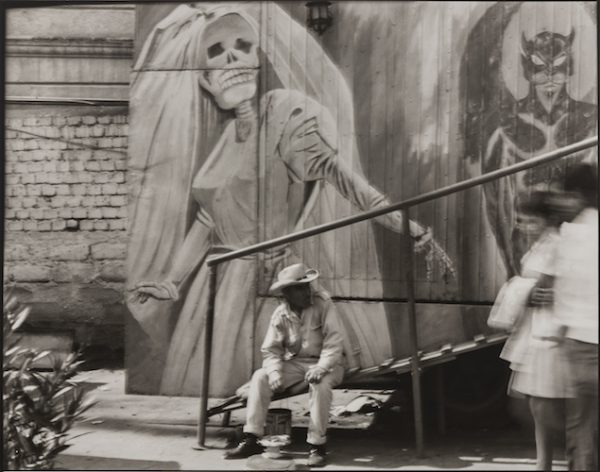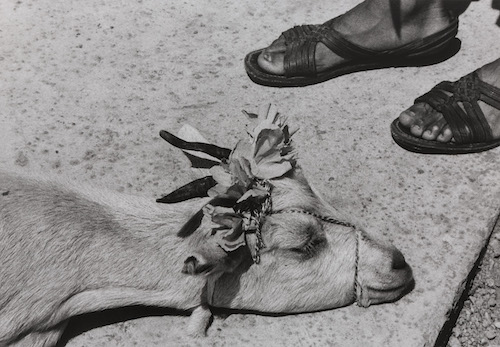Visual Arts Review: “Graciela Iturbide’s Mexico” — Casting a Coolly Warm Eye on Life and Death
By Robert Israel
In Graciela Iturbide’s photographs, the living and the dying are often joined at the (exposed) skeletal hip.

Graciela Iturbide, “House of Death, Mexico City.” Photo: Courtesy of the Museum of Fine Arts, Boston
Graciela Iturbide’s Mexico, at Boston’s Museum of Fine Arts (through May 12) is generous and engaging exhibit of the work of a powerful photographer who casts a penetrating, yet compassionate, eye on life and death. Besides its aesthetic value, the exhibit arrives at a crucial political time. Congressional debates on sealing our southern border place a discomforting focus on our marginalization of Mexicans. Iturbide’s work is the best argument for why diplomacy is a vital imperative: her photographs show us why we must be connected, not separated, from our southern neighbors.
Iturbide works in black and white. Her primary subject is Mexico’s indigenous people who live hardscrabble, impoverished lives, and who practice centuries-old rituals rooted in Christianity, folklore, farming, and animal husbandry. These rituals are universal, proof that current ‘borders’ are man-made, artificial demarcations that must be transcended.
A 77 year-old Mexico City-born photographer, Iturbide studied with the celebrated late 20th century Mexican photographer Manuel Alvarez Bravo. She also credits the late Mexican Nobel Laureate Octavio Paz as a poetic influence. Her vision goes beyond stereotypes — her people are not ‘salt-of-the-earth’ but odd and superstitious, enigmatic expressions of humanity.
Iturbide tells us (in a video interview included in the exhibit) that she prefers to capture her subjects by surprise. Whenever possible, she takes her pictures serendipitously. The late 20th century American photographer Walker Evans’ also said that his best work came to him unplanned. Also like Evans, Iturbide seeks out subjects she perceives as threatened, their way of life endangered in some way. She avoids scripting or posing her figures into formal portraits. By catching them off-guard, she hopes to capture their uninhibited vitality. Furthermore, she insists we look on these men, women, and children with pitiless clarity.
Because Iturbide is non-judgmental, her work is not for the squeamish. Several of the photos here look, in detail, at the bodies of slaughtered goats, chickens, iguanas, and alligators. I did not find these images repugnant; in fact, I was drawn to them. They reminded me of my youth, spent in an observant Jewish community. I was taken to a kosher butcher shop and witnessed the weekly slaughtering of live poultry, where later prepared by my grandparents for our Sabbath meal.

Graciela Iturbide, “The Little Goat’s Death Before the Slaughter.” Photo: Courtesy of the Museum of Fine Arts, Boston.
The exhibit is heavily palled by images of death. There’s a striking photo of an abandoned corpse desecrated by a flock of flesh-eating birds. His disheveled body lies on a cemetery path. Ironically, the macabre scene is accented by gallows humor. The corpse is dressed in a black funeral suit (as in prints by 19th century Mexican caricaturist Jose Guadalupe Posada); it looks if the dead man had been running toward his own open grave — but he didn’t quite make it.
In Iturbide’s work, the living and the dying are often joined at the (exposed) skeletal hip. There are photos of earthbound angels, complete with plastic gossamer wings, as well as parents carrying a child’s casket to the cemetery. Throughout the exhibit there is a mysterious Manichean tension, a contest between darkness and light that generates wonder.
Irish poet William Butler Yeats, in his epitaph, wrote that his life’s mission was to “cast a cold eye on life, on death.” Iturbide follows in the poet’s footsteps, though with a caveat: she acknowledges — and faithfully captures — the cool warmth that emanates from the people of her beloved homeland.
Robert Israel writes about theater, travel, and the arts, and is a member of Independent Reviewers of New England (IRNE). He can be reached at risrael_97@yahoo.com.
